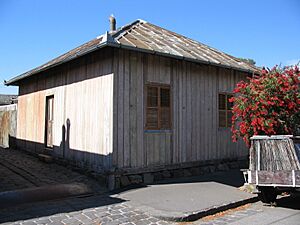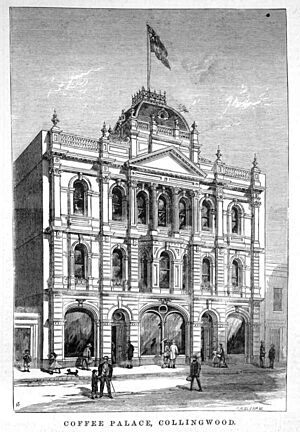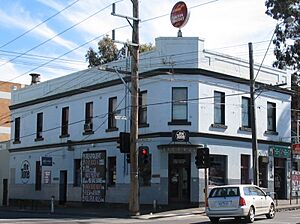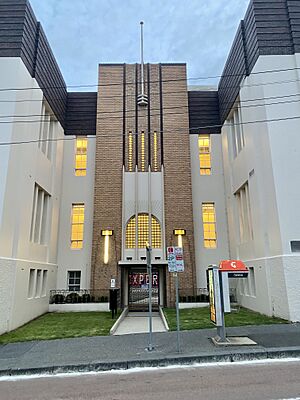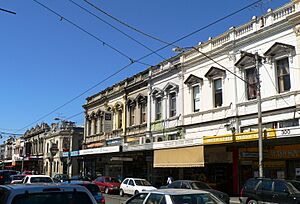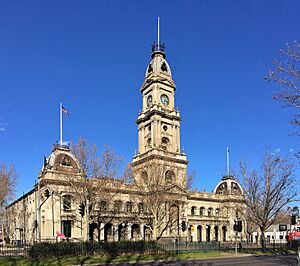Collingwood, Victoria facts for kids
Quick facts for kids CollingwoodMelbourne, Victoria |
|||||||||||||||
|---|---|---|---|---|---|---|---|---|---|---|---|---|---|---|---|
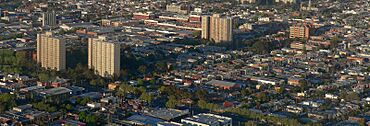
Aerial view of Collingwood looking south west toward Victoria Parade; Hoddle Street (left) and Smith Street on (top right)
|
|||||||||||||||
| • Density | 7,217/km2 (18,690/sq mi) | ||||||||||||||
| Established | 1850s | ||||||||||||||
| Postcode(s) | 3066 | ||||||||||||||
| Elevation | 25 m (82 ft) | ||||||||||||||
| Area | 1.3 km2 (0.5 sq mi) | ||||||||||||||
| LGA(s) | City of Yarra | ||||||||||||||
| State electorate(s) | Richmond | ||||||||||||||
| Federal Division(s) | Melbourne | ||||||||||||||
|
|||||||||||||||
Collingwood is a lively suburb located very close to the center of Melbourne, Victoria, Australia. It's about 3 kilometers (2 miles) north-east of the city's main area and is part of the City of Yarra. In 2021, about 9,179 people lived here.
The land where Collingwood now stands was originally called Yálla-birr-ang by the Wurundjeri people. They are the traditional owners of this area. After European settlement, the suburb got its name in 1842. It was named after Cuthbert Collingwood, 1st Baron Collingwood, a famous admiral, or perhaps after a hotel named after him.
Collingwood is one of Melbourne's oldest suburbs. It is surrounded by Smith Street, Alexandra Parade, Hoddle Street, and Victoria Parade.
The suburb is famous for its old buildings. Many homes, shops, and factories from the 1800s are still used today. Smith Street is a major street known for its shops and nightlife. It has even been called the "coolest street in the world." Collingwood used to be an industrial area, but now it's a hub for creative arts businesses.
Contents
History of Collingwood
How did Collingwood get its name?
The suburb was named in 1842 by surveyor Robert Hoddle. He was following instructions from Superintendent Charles La Trobe. The name honors Cuthbert Collingwood, 1st Baron Collingwood, who was a favorite admiral of Lord Horatio Nelson. It might also have been named after the Collingwood Hotel, which was already there.
When was Collingwood established?
Land in Collingwood started to be sold in 1838. Most of the land was sold by the 1850s. Collingwood became its own municipality (a local government area) on April 24, 1855. It was one of the first areas to do so after Melbourne and Geelong. Collingwood was declared a town in 1873 and then a city in 1876.
Collingwood grew quickly because of the Victorian gold rush in the 1850s and 1860s. Melbourne's population and economy boomed during this time. Many small homes, schools, shops, and churches were built to support the new residents. Large factories, like a flour mill and the Fosters brewery, also started up.
Collingwood in the 19th and 20th Centuries
By the 1870s, Smith Street became the main shopping area. A tram line was built there in 1887. Many grand public buildings, like the post office and town hall, were built in the 1880s. Collingwood also had a strong movement against alcohol. Two "coffee palaces" (places that served coffee instead of alcohol) opened in the 1870s. One of these, the Collingwood Coffee Palace, is now part of the Woolworths store on Smith Street.
Around 1900, Smith Street was as important for shopping as Chapel Street in Prahran. The very first G.J. Coles store opened on Smith Street in 1912.
Since the 1950s, many groups in Collingwood have worked to protect the suburb's unique character. They have fought against new developments that might change the area too much. For example, in 1958, residents protested against plans to demolish 122 homes.
Recent History of Collingwood
In 2006, the Collingwood Action Group was formed. They fought against a large building project on Smith Street called "Banco." In 2010, over 2,000 people protested to save The Tote Hotel. This is a very popular place for live music.
More recently, Collingwood has seen growth in its office sector. Many new office buildings have been built in the southern part of the suburb. Some major companies have even moved their main offices here.
Geography and Buildings
Collingwood is mostly flat. However, there is a noticeable slope from Hoddle Street up to Smith Street.
The suburb is known for its many historic buildings. Many homes, shops, and factories from the 1800s are still in use. From its early days, large commercial buildings often stood next to small homes. These homes were lived in by working-class families. This mix of industry and community continues today. For example, Oxford and Cambridge Streets have large brick factories. These used to belong to Foy & Gibson. But you can also find older stone, brick, and timber homes there.
Collingwood's Culture
Sports in Collingwood
The Collingwood Football Club was founded in 1892. They used to play at Victoria Park. Now, they are based at the Melbourne Cricket Ground (MCG).
They won the 2023 Grand Final against the Brisbane Lions. Collingwood has won 16 VFL/AFL premierships. This is the most wins in the league, tied with Carlton and Essendon. They also won the 1896 VFA premiership.
Community Radio Stations
3CR is a community radio station in Collingwood. It is located near the Victoria Parade end of Smith Street. The station has been in Collingwood since 1977. You can listen to it on 855AM.
PBS 106.7FM also moved to Collingwood from St Kilda. It is located at 47 Easey Street. PBS is another community radio station. It celebrated 25 years of broadcasting in 2004.
Arts and Creativity
The Collingwood Arts Precinct is called Collingwood Yards. It is built on the site of the old Collingwood Technical School. It opened on March 13, 2021. Circus Oz is also located in the Yards on Perry Street. They have a special performance tent called the Melba Spiegeltent.
Economy and Businesses
Several major companies have their main offices in Collingwood. These include the airline Jetstar, the media company Madman Entertainment, the vitamin brand Swisse, and the cosmetics brand Aesop. Many architecture firms also have offices in Collingwood and nearby Fitzroy. This includes the main office of DKO Architecture.
Shopping and Commercial Areas
The main shopping and business area is Smith Street. This street forms the border with Fitzroy. In 2021, Smith Street was named the "coolest street in the world."
Education in Collingwood
Collingwood Technical School started in July 1912. It was a school for trades and technical training. The school closed in 1987. It then combined with the Preston Technical School to form Melbourne Polytechnic. Melbourne Polytechnic still has a campus in Collingwood on Otter Street. In 2022, work began to upgrade this campus.
Collingwood College is a state school for students from Prep to Year 12. It is located in the suburb. Collarts is a private college also in Collingwood. Its main campus is on Wellington Street. It offers degrees in design and creative arts.
People and Housing
Population Changes
Collingwood's population has grown over the years:
- 2001: 5,081 people
- 2006: 5,493 people
- 2011: 6,467 people
- 2016: 8,513 people
- 2021: 9,179 people
In the 2021 census, there were 9,179 people in Collingwood. About 58.4% of people were born in Australia. Other common countries of birth included England (4.3%), New Zealand (3.6%), and Vietnam (3.1%). Most people (68.3%) spoke only English at home. Other languages spoken included Vietnamese (4.0%) and Mandarin (2.2%). The most common answer for religion was "No Religion" (58%).
Housing in Collingwood
Collingwood has many high-rise public housing flats. It also has many older, single and double-story cottages. These were once homes for workers.
More recently, old warehouses and factories have been turned into apartments. New townhouses and medium-sized apartment buildings have also been built.
Local Government
The City of Collingwood existed from 1855 until 1994. Now, Collingwood is part of the City of Yarra local government area.
Important Buildings
Collingwood has many buildings listed on the Victorian Heritage Register. This means they are important historical sites.
The Yorkshire Brewery was built in 1880. It was designed by James Wood. With its colorful bricks and unique roof, it was once Melbourne's tallest building. The old Collingwood Post Office was built between 1891 and 1892. It has a tall tower and a special architectural style.
Some well-known hotels include the Leinster Arms Hotel, built in 1865. It's the only single-story hotel from that time in Melbourne. Other hotels are the Sir Robert Peel ("The Peel") Hotel and the Vine Hotel.
The original Collingwood Magistrates' Court closed in 1985. But because there was still a local need, the Neighbourhood Justice Centre court opened in 2007.
Even though it's called the Collingwood Children's Farm, it's actually in the next suburb, Abbotsford.
Getting Around Collingwood
The roads in Collingwood are mostly narrow and one-way. The suburb is bordered by major roads: Smith Street to the west, Victoria Parade to the south, Hoddle Street to the east, and Alexandra Parade to the north.
Major tram routes run along Victoria Parade (tram route 109 and tram route 12) and Smith Street (route 86). These are on the edges of the suburb. Johnston, Wellington, and Langridge Streets are the main roads that go through Collingwood.
The suburb is also served by nearby train stations: Victoria Park and Collingwood railway stations. These are located in neighboring Abbotsford.
Special bike lanes for north-south travel were added on Wellington Street starting in 2013. They now reach Victoria Street. In 2018, the speed limit in the northern parts of Collingwood and Fitzroy was lowered to 30 km/h. This was a first for Melbourne.
Famous People from Collingwood
- Emma Minnie Boyd (1858–1936), an artist
- Edward Petherick (1847–1917), a bookseller and book collector
- Keith Stackpole (born 1940), a cricketer



